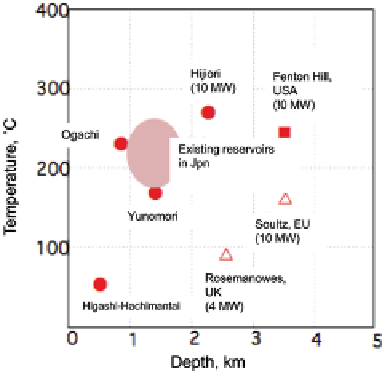Environmental Engineering Reference
In-Depth Information
from the surface penetrates to close to the magma area and absorbs the heat. Return
flow path is determined by the fractures or faults which exist naturally. When all
three conditions are met then a viable extraction is possible, but in many cases all
three conditions are not all met at the same time.
Reservoir engineering is designed to determine the volume of geothermal re-
sources and the appropriate plant design for sustainable use and safe and efficient
operation. Where flows are inadequate, this may require the creation of an artificial
or engineered geothermal energy system of which a critical part is hydraulic frac-
turing or stimulation. The modern method of estimating reserves and sizing power
plants is to apply reservoir simulation technology. A conceptual model is built using
available data, it is then translated into a numerical representation, and calibrated
to the unexploited, initial thermodynamic state of the reservoir (Grant et al.
1982
).
Critical parts of the overall reservoir simulation are to model the effects of fractur-
ing in the EGS, to predict the effects of such stimulation and design optimum strate-
gies for the EGS.
Knowledge of temperature at drillable depth is a prerequisite for site selection
for any EGS development. The thermo-mechanical signature of the lithosphere and
crust are equally important as they provide critical constraints affecting the crustal
stress field, heat flow and temperature gradients. Many rocks will already contain
natural fractures in the rock mass, and it is imperative to assess their distribution
(hole drilling will reveal some of the existing rock characteristics including natu-
rally occurring fractures) which can then inform the design of the fracturing stimu-
lation. Modelling and simulation may play a role and, for the development of mass
transport modelling, an artificial geothermal system can be modelled where a reser-
voir is artificially created by hydraulic stimulation and the fractures connected with
two drilled boreholes. Circulation using the reservoir is then performed by injecting
cold water into the injection well and recovering it through the production well.
A number of research projects on HDR/HWR have been performed internationally
at sites of several countries with various temperatures, depths and locations (Fig.
6.7
).
Fig. 6.7
HDR/HWR projects
conducted to date

